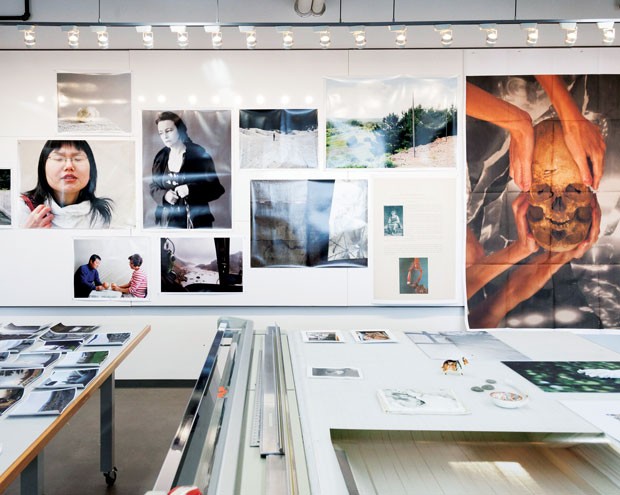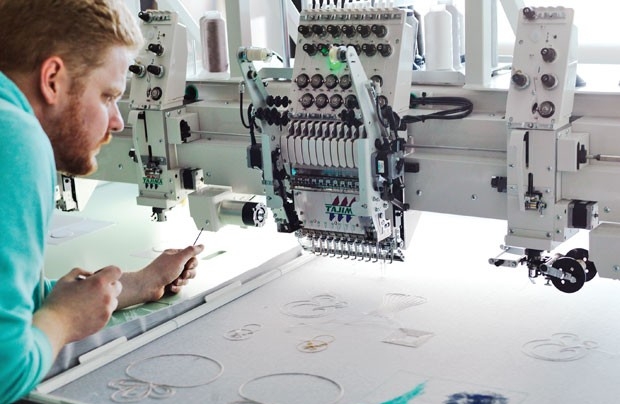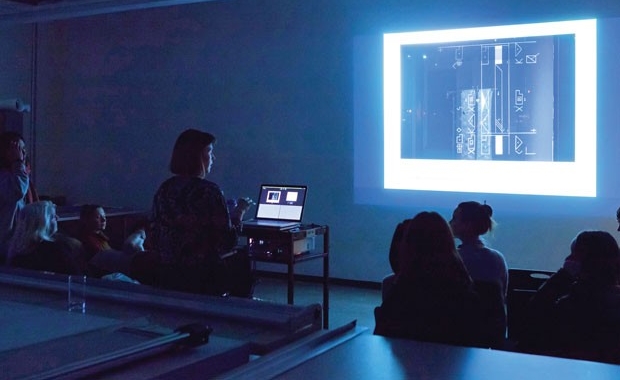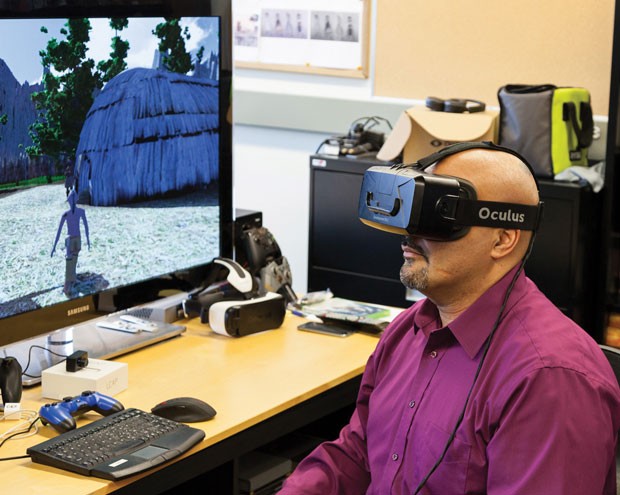A meeting ground without borders
The first thing a visitor notices when entering Milieux’s central administration office in Concordia’s Engineering, Computer Science and Visual Arts Integrated Complex is a massive whiteboard occupying most of a wall. It’s covered in ink, with lines shooting out from the central Milieux logo. Each line leads to one of seven destinations — clusters, they’re called. Each cluster is surrounded by the names of Concordia staff and students associated with it.
Lines swoop between and among the names, linking separate individuals from different clusters in a complex, almost bewildering spaghetti of interconnectivity. There is a serpentine fluidity there, suggesting that nothing is static, that none of the clusters are hermetic.
And that is precisely the point.
 You can be in the TAG room and you can drop in on a conversation about design, or the social issues about games, or just about anything, with very smart people.
You can be in the TAG room and you can drop in on a conversation about design, or the social issues about games, or just about anything, with very smart people.
Open since March 2016, Milieux is a research institute that its founders and researchers say is unlike anything in the country. As its name suggests, it is a meeting place between disciplines where the exchange of ideas is not only encouraged but part of its very function. From games to textiles, from engineering to media history, Milieux is like a creative mashup limited only by the imagination of the people who work there.
If that sounds vague, perhaps that’s because the concept of Milieux is a bit tricky to define. Known formally as the Milieux Institute for Arts, Culture and Technology, it is essentially an umbrella organization that houses seven clusters, each with its own staff and students and each conducting independent research.
Those seven clusters are all forward-looking in how they approach traditional — and not so traditional — areas of re-search. The Post Image cluster, for instance, looks at the changing nature of photography; Technoloculture, Art and Games (TAG) examines the social aspect of gaming culture; Initiative for Indigenous Futures imagines Aboriginal culture in the digital age.
The other four clusters are Media History; Textiles and Materiality; Performance, Immersion and Interactivity; and Community and Differential Mobilities.
“The names came from the members or their representatives,” says Milieux’s director Bart Simon, associate professor in Concordia’s Department of Sociology and Anthropology. “They weren’t sud-den things. The thought was, does this fit what we’re doing, does this not fit what we’re doing? The clusters them-selves come out of articulations of the critical mass of research which we think is strategically oriented,” he says.
“In other words, if we were going to put a group of people together who had something in common to talk about, could they leverage their work into something more, whether it be research funding or impact on the community, productivity, recruitment of students, and these sorts of things?”
The collaborative nature of the work conducted by the institute’s roughly 80 faculty and staff and 120 students serves a double purpose: to inspire re-search beyond the traditional silos that normally constrain specialists, and to pool resources to allow the purchase of equipment that would be beyond the reach of any single researcher. Simon admits that while this may require some academics to give up a bit of autonomy, they more than make up for it with the tools they subsequently gain.
WhiteFeather Hunter, MFA 16, coor-dinator for the Speculative Life Lab and for the Textiles and Materiality cluster, says doing her work alongside others at Milieux requires dialogue and inter-action between people with disparate backgrounds: an arts person speaks to a science person who speaks to a games person who speaks to a sociology person who speaks to an engineer. “It gets really exciting because you have people who normally communicate in completely different languages learning how to communicate in a common language,” she says. “And it’s a new language.”

New meets old
While Milieux is new, many of the study groups that are its component parts are not. The Media History and Community and Differential Mobilities groups, for instance, existed long before Milieux. Simon co-founded TAG along with Lynn Hughes, now the Concordia University Research Chair in Interaction Design and Games Innovation, in 2009.
And Milieux itself grew out of Hexagram, which was also a Concordia-based research institute until its federal funding ended. It was after Hexagram had to shutter its doors that Simon, Hughes and Hexagram’s director Chris Salter began the year-long brainstorm that eventually resulted in the Milieux concept. The new institute was able to access Hexagram’s existing infrastruc-ture yet set itself up as something more flexible and more autonomous.
While this emphasis on inter-cluster collaboration is still in its infancy, there is no shortage of innovative and surpris-ing work going on. Take, for instance, Simon’s particular cluster, TAG. Its emphasis on gaming goes well beyond spirited discussions about platforms and titles and the multibillion-dollar industry behind them. The students at TAG are mostly pursuing PhDs, reports its director Hughes, and while some are writing traditional theses, others are mixing writing with making and designing games. And not just your traditional console games either. “While individual player games are not something we discourage, they are by no means the most important thing that we do,” Hughes says. “The screen, and the individual, are not always the focus of games designed at TAG.”
Despite the decades-long digital dominance of the games industry, Hughes says she has seen a resurgent interest in board and card games among her students. She mentions one card game called Cabinet Shuffle, developed at TAG by Will Robinson, which mixes ethics, politics and strategy. There are also games that are very physical, such as ones involving digitally augmented costumes — which could include collaborating with someone from the Textiles and Materiality cluster. Games produced in the Initiative for Indigenous Futures cluster reimagine the content of games to provide a focus on Aboriginal characters.
“We’re trying to make research work differently,” Hughes says. “There’s no rule book, but we want to build close relations between the clusters. What the students do between the clusters is what is most important. Students are looking for connections — it’s what this period of life is about.”

Crossing clusters
Those connections — in and out of the university — are key to students like Jessica Rose Marcotte, BA 12, MA 14. Currently a TAG student pursuing her PhD in game design and game studies, Marcotte describes her work as feminist. She created a game called In Tune that “navigates consent using skin-to-skin contact.”
She describes In Tune as “a game that deals with bodies, their interac-tions and giving/withholding consent. Players are asked to negotiate and communicate their own physical boundaries with a partner using skin-to-skin contact as the main controller of the game,” Marcotte explains. “Its goal is to develop players’ skills to navigate con-sent and physical interactions while hopefully provoking thought about how daily interactions with people and the space around them also involves simi-larly complicated negotiations. It is also looking to have players examine their own comfort levels and see how thoughtful communication has the potential to shift those levels.”
Marcotte says the freedom, facilities and access TAG — and by extension, Milieux — provide are distinctive. “You can be in the TAG room, and all of a sudden you can drop in on a con-versation about design, or the social issues about games, or just about any-thing, with very smart people who know a lot about this stuff,” she says. “Or you can go downstairs to the Textiles and Materiality lab to discuss wearables and you’ll have the doors open and somebody is ready for a chat.”
Hughes says this kind of mobility and cluster-crossing is a natural part of Milieux’s purpose. And it is not simply limited to students and staff within the institute or even within the university. Interacting with outside actors, includ-ing representatives from businesses such as those in Montreal’s thriving video game industry, is expected and encouraged. “Our mission is to pull people in and to push our people out,” she says.
Milieux plans to hold regular public events, like TAG’s ARCADE 11, which is part of the city’s Montréal joue festival and draws around 600 people to Milieux’s 11th-floor spaces every year. Besides the student-run weekly 5-à-7s, TAG also runs a 10-week game incubation program over the summer. The research centre is also closely affiliated with community-based games organizations such as the Mount Royal Gaming Society, the city’s independent-minded monthly meetup.
 Whitefeather Hunter recently completed her Concordia MFA in fibres and material practices. “If you want to simplify it, you could just say I’m growing flesh on textiles.”
Whitefeather Hunter recently completed her Concordia MFA in fibres and material practices. “If you want to simplify it, you could just say I’m growing flesh on textiles.”
WhiteFeather Hunter, who recently completed her MFA in fibres and material practices at Concordia, finds that Milieux’s fluidity allows her to pursue her interests in looking at how biology and textiles intersect. She says there is a growing curiosity about the field of bio-art, which she defines as “art that uses living organisms — or semi-living, because they can’t thrive outside of a lab sometimes — as art material.”
Hunter is engaged in tissue engineer-ing. “I’m growing living mammalian tissues onto textiles that I’ve woven by hand,” she explains. Hunter has grown human bone cancer and mouse connective tissues. “If you want to simplify it, you could just say I’m growing flesh on textiles.”
She points out that this kind of art-work just isn’t being done in Canada — in fact, while she was pursuing her MFA, she took up a residency at SymbioticA, an artistic laboratory at the University of Western Australia in Perth. “So this is where Milieux becomes really cutting edge,” Hunter says.
While she wishes the facilities Milieux offers had been available a few years ago, Hunter is thankful that she can continue to pursue her work now. Yet the lab’s purpose is not solely for bio-art. Part of the room is a dedicated electronic makerspace, where researchers work on projects that examine the meeting place of electronic and living systems. Hunter and her thesis advisor, media artist Tagny Duff, MFA 05, PhD 14, associate professor in Concordia’s Department of Communication Studies, have both had their bio-art work displayed in galleries.
The institute, Hunter says, “makes biological research more accessible to people through artistic representation. It makes artistic research more acces-sible to a variety of people, so it expands the audience. And it expands the po-tential collaboration that can happen. Collaboration is the way to go, especially in terms of funding, because people want to see that their investments are going twice as far. And that’s what’s happening here.”
 Jason Edward Lewis is professor of design and computation arts and university research chair in computational media and the Indigenous Future Imaginary.
Jason Edward Lewis is professor of design and computation arts and university research chair in computational media and the Indigenous Future Imaginary.
Sci-fi elements
If some of what Hunter is working on sounds almost like the basis of a science-fiction story, down the hall on the Engineering, Computer Science and Visual Arts Integrated Complex’s 10th floor, the Initiative for Indigenous Futures cluster is diving in head first. The cluster’s director Jason Edward Lewis, professor of Design and Computation Arts, and its coordinator Skawennati, BFA 92, GrDip 96, say they are trying to get researchers to look at how Indigenous peoples and communities are imagining their future. In practical terms, that means supporting Indigenous artists and their work, particularly in digital media, and by bringing in non-artists such as people working on issues like food sovereignty, law or land use.
“We’re thinking about the far future, like a science-fiction-type future,” says Skawennati. “As native people, we often talk about seven generations, so that’s sort of the area that we’re looking at.”
“We want people to look beyond the current challenges, not because we think they’re insignificant by any means, but as a way of freeing up some imagina-tive space to think about the issues and challenges we have right now,” says Lewis. “We found that was actually not happening a lot within the Indigenous community and we want to provide several different venues in which that can happen.”
The Initiative for Indigenous Futures cluster not only supports digital and non-digital artists. It also organizes annual symposiums as well as running youth workshops on Aboriginal storytelling and digital media design. Yet the cluster has also changed its agenda. While it began as a centre for investigating the intersection of Indigenous culture and digital media — such as, for example, translating traditional Aboriginal stories into digital media — it has since become something far more broad. Outside speakers can include not just lawyers and activists but also ironworkers discussing their jobs far above a busy city street or founders of First Nations start-ups. While the cluster’s expertise is in digital media, it is no longer the only thing they do.
As for the kinds of stories being told by students, creators and scholars, Skawennati says, “We’re seeing a lot of Indians in space. I think a lot of people are using space exploration as a metaphor for the future.”
“Also, space exploration plugs into narratives of colonization,” adds Lewis. “They’re using space and the future narrative to reimagine what a first encounter might be like, what interaction with aliens might be like, to reimagine the history of this continent, and things like that.” Over the next weeks and months, Simon and the Milieux team will be doing their best to let people — from the Concordia community, the business community and the general public — know they exist. He says that is a natural extension of the horizontal plane the institute operates on. Still, he notes, “We don’t say we’re industry-leaning or we’re an incubator or an accelerator or any of that stuff, because at the same time, alongside business leaders, we’re working with museums and galleries, activist groups, schools and libraries. It’s a total meeting ground.”
Related links